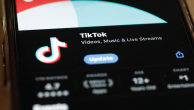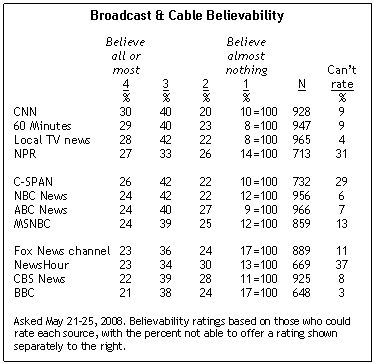
The public continues to express skepticism about what they see, hear and read in the media. No major news outlet – whether broadcast or cable, print or online – stands out as particularly credible.
There has been little change in public perceptions of the credibility of most major news organizations between 2006 and 2008. Over the last 10 years, however, virtually every news organization or program has seen its credibility marks decline.
In 1998, for example, 42% of those who could rate CNN gave it the highest rating for credibility (four on a scale from one to four). That fell to 28% in 2006, and remains low in the current survey (30%). Credibility ratings for several other television news organizations – including the three major broadcast news outlets – also have declined since 1998. Comparable percentages say they can believe all or most of what NBC News (24%), ABC News (24%) and CBS News (22%) report (based on those who can rate those organizations).
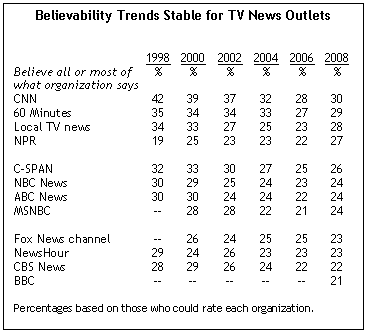
Credibility ratings for the Fox News Channel have remained largely stable in recent years. Currently, 23% say they can believe all or most of what they hear from Fox, down slightly from 2006 and 2004 (25%).
About a quarter (27%) who can rate NPR give it the highest credibility rating, up five points since 2006. NPR is viewed as somewhat more credible today than in 1998 (27% vs. 19%).
The credibility ratings for local TV news also have gone up a bit since the last media consumption survey (from 23% to 28%). But a decade ago, 34% said what they saw and heard on their local TV news was highly credible.
Print Credibility Also Low
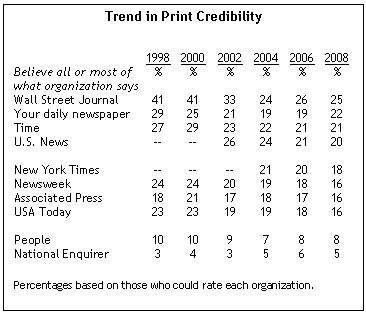
A quarter of those able to rate The Wall Street Journal give that newspaper the highest credibility marks. That is slightly more than say the same about their own daily paper (22%). The Journal also gets higher marks than The New York Times (18%) or USA Today (16%).
A decade ago, however, fully 41% gave the Journal the highest credibility ratings. The proportion of people who believe all or most of what they read in the Journal began to slip in 2002 and has stood at about one-in-four since 2004.
Ratings for the Times have been fairly consistent since 2004, the first year the newspaper was asked about. Ratings for USA Today are somewhat lower now than they were in 1998 or 2000 (23% then vs. 16% currently).
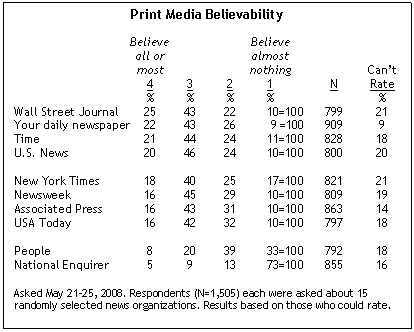
It should be noted that Americans view most traditional news sources – print, TV and radio – as at least somewhat credible, rating them at least three on the one-to-four scale. Notable exceptions are People magazine – only 28% of those who could rate it give it a rating of three or four – and the National Enquirer; just 14% give the supermarket tabloid a three or four.
Online News Sites
Online news outlets are viewed with more skepticism than their print, broadcast and cable counterparts. Of seven organizations evaluated, none is viewed as highly credible by even a quarter of online users able to rate them.
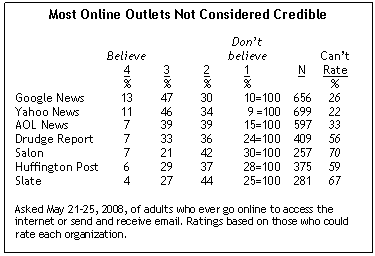
Only Google News and Yahoo News – which derive much of their content from traditional news organizations – receive positive marks for credibility by most users who could rate them. Six-in-ten give Google News a rating of three or four, but just 13% give Google News the highest rating for credibility. Nearly as many give Yahoo News a rating of three (46%) or four (11%). AOL News gets a rating of three or four from fewer than half of internet users who could rate it (46%).
Online magazines Slate and Salon do not fare as well. Among those who could rate them, just 31% give Slate a three or four credibility rating, while 28% offer such similar ratings for Salon. These ratings are based on a relatively small group able to rate these outlets: 70% of internet users could not rate Salon, and 67% could not evaluate Slate.
When asked about the Drudge Report, four-in-ten internet users who could rate it give it a believability rating of three or four. Slightly more than a third (35%) said the same about the Huffington Post. More than half of internet users could not rate the Drudge Report (56%) or the Huffington Post (59%).
Partisan Gap in Credibility Ratings
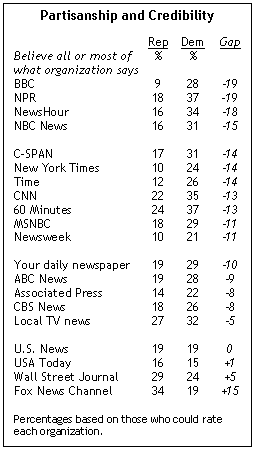
Democrats continue to give most news organizations much higher credibility ratings than do Republicans. When it comes to the British Broadcasting Corporation (BBC), for example, Democrats who can rate that organization are three times as likely as Republicans to give it the highest credibility rating. Far more Democrats than Republicans also give believability ratings of four to NPR, PBS’s NewsHour with Jim Lehrer, NBC News, and several other news organizations.
Republicans are substantially more likely to give the highest credibility rating to the Fox News Channel (34%) than are Democrats (19%). Fox ranks very low in credibility among Democrats; still, Fox’s ratings among Democrats are much higher than Republican ratings for The New York Times (10% give it a four) or BBC (9%).
Partisan differences in credibility ratings for news organizations have fluctuated in recent years. In 2004, for example, there was a 19-point gap between Democrats and Republicans when it came to CBS News. That dropped to 11 points in 2006 and 8 points this year. The gap for ABC News fell from 18 points in 2004 to 9 points in 2006 and remains at 9 points this year. Most of the narrowing of the difference has been driven by Democrats lowering their estimation of each network’s credibility.
By contrast, evaluations of The New York Times have become more divided. In 2006, 16% of Republicans gave the newspaper a top-credibility rating; that fell to 10% in the current survey. Democratic ratings for the Times have remained stable (23% top rating in 2006, 24% in 2008).
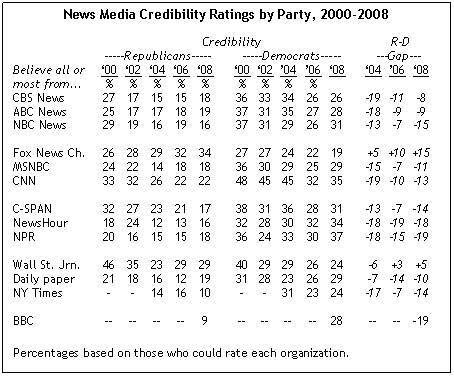
Similarly, the partisan gap in credibility ratings for Fox News has tripled since 2004. The proportion of Republicans giving Fox the highest marks for credibility have increased over the past four years (from 29% to 34%), while Democrats’ ratings have declined (from 24% to 19%).
